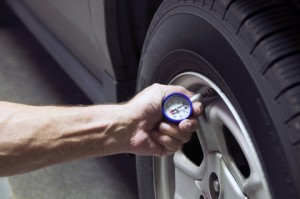One of the ways we that we come up with blog post ideas is that we look at competing blogs to find topic ideas that we haven’t yet covered. By simply taking a title, topic, or keyword, we then write our own nitrogen tire inflation article with our own perspective and information. It was through this routine process the other day that we came across a video of… ourselves.
While looking through the competitor’s blog, we found a post that had a video in it. We noticed that in the video screenshot was a man that looked a lot like Ken Lawton, the CEO of Nitrofleet99. Curious, we watched the video. Sure enough, it was Ken! Not only did this competitor post a video that showcased his competitor very clearly (the video introduces Ken and shoots a few seconds of Nitrofleet99’s banner) , the video was an interview with Ken about nitrogen tire inflation. The competitor was never featured in the two and half-minute piece! We found it interesting that our competitor shared a video about nitrogen tire inflation, but failed to consider the his direct competitor was the one prominently featured as the source and expert on the issue. He focused too much on the fact that the video was about nitrogen tire inflation.
We couldn’t not share this video and this story! The video (which is part one of two, another fact the competitor failed to notice) and its transcript are below. We will share part two and its transcript next week.
Transcript
But, with the average price of gas in St. Louis at $3.87 a gallon this morning, filling up your tank is not something to be taken lightly these days. But, there are ways to save a little money at the pump and Heidi Glaus is here to share the secrets. Heidi-
Glaus: Yeah, well there’s a lot to know about filling your tires and what that can do for your gas mileage. So, this is Ken Lawton and you’re all about the nitrogen, which is some people have probably heard about but maybe they don’t know exactly what filling your tires with nitrogen can do.
Lawton: Heidi, nitrogen tire inflation has been around for a very long time. The military, the NASCAR community, and big business has been using nitrogen for over twenty years.
Glaus: So, what you’re saying is that it hasn’t really been affordable to the common person for the last few years?
Lawton: It is completely been unaffordable due to the technology changes; in recent years have made it affordable to automotive groups and tire stores and the public in general. So, it is come of age.
Glaus: So what are we talking; what are the benefits of using nitrogen instead of, you know, oxygen?
Lawton: Well, it begins with aging. The oxygen in air degredates tires and causes premature aging. The tire of simply wears out more quickly. With nitrogen, what you have is the benefit of a completely dry, inert air that simply makes the tire perform as a hybrid. What you’re doing by converting to nitrogen is creating a hybrid tire.
Glaus: Really! So, we hear all about the hybrid cars and all of that and this is just what we’re doing to the tires. So, how much can somebody save on gas mileage by filling a tire with nitrogen?
Lawton: Well, various studies have been done by Ford Motors, Exxon Mobil has done studies as well. What we’re finding is savings up to ten percent on fuel and extended tire wear by up to 30 percent. This is significant information for consumers.







